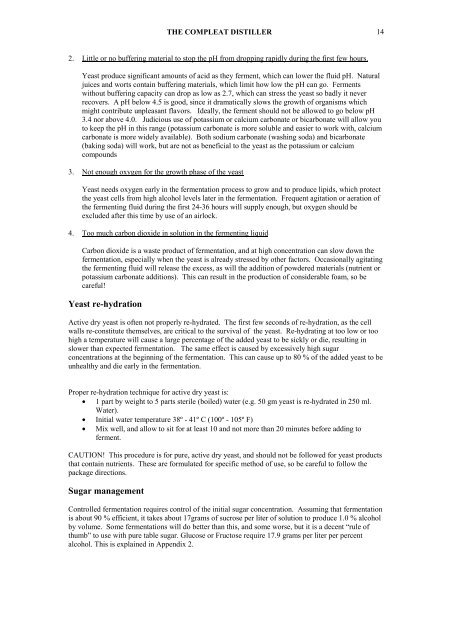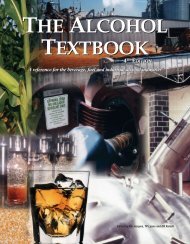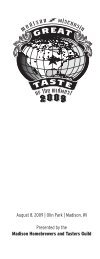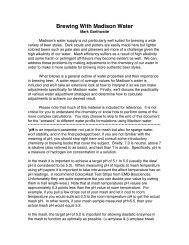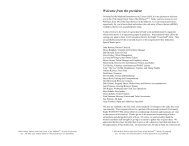The Compleat Distiller
The Compleat Distiller
The Compleat Distiller
You also want an ePaper? Increase the reach of your titles
YUMPU automatically turns print PDFs into web optimized ePapers that Google loves.
THE COMPLEAT DISTILLER 14<br />
2. Little or no buffering material to stop the pH from dropping rapidly during the first few hours.<br />
Yeast produce significant amounts of acid as they ferment, which can lower the fluid pH. Natural<br />
juices and worts contain buffering materials, which limit how low the pH can go. Ferments<br />
without buffering capacity can drop as low as 2.7, which can stress the yeast so badly it never<br />
recovers. A pH below 4.5 is good, since it dramatically slows the growth of organisms which<br />
might contribute unpleasant flavors. Ideally, the ferment should not be allowed to go below pH<br />
3.4 nor above 4.0. Judicious use of potassium or calcium carbonate or bicarbonate will allow you<br />
to keep the pH in this range (potassium carbonate is more soluble and easier to work with, calcium<br />
carbonate is more widely available). Both sodium carbonate (washing soda) and bicarbonate<br />
(baking soda) will work, but are not as beneficial to the yeast as the potassium or calcium<br />
compounds<br />
3. Not enough oxygen for the growth phase of the yeast<br />
Yeast needs oxygen early in the fermentation process to grow and to produce lipids, which protect<br />
the yeast cells from high alcohol levels later in the fermentation. Frequent agitation or aeration of<br />
the fermenting fluid during the first 24-36 hours will supply enough, but oxygen should be<br />
excluded after this time by use of an airlock.<br />
4. Too much carbon dioxide in solution in the fermenting liquid<br />
Carbon dioxide is a waste product of fermentation, and at high concentration can slow down the<br />
fermentation, especially when the yeast is already stressed by other factors. Occasionally agitating<br />
the fermenting fluid will release the excess, as will the addition of powdered materials (nutrient or<br />
potassium carbonate additions). This can result in the production of considerable foam, so be<br />
careful!<br />
Yeast re-hydration<br />
Active dry yeast is often not properly re-hydrated. <strong>The</strong> first few seconds of re-hydration, as the cell<br />
walls re-constitute themselves, are critical to the survival of the yeast. Re-hydrating at too low or too<br />
high a temperature will cause a large percentage of the added yeast to be sickly or die, resulting in<br />
slower than expected fermentation. <strong>The</strong> same effect is caused by excessively high sugar<br />
concentrations at the beginning of the fermentation. This can cause up to 80 % of the added yeast to be<br />
unhealthy and die early in the fermentation.<br />
Proper re-hydration technique for active dry yeast is:<br />
• 1 part by weight to 5 parts sterile (boiled) water (e.g. 50 gm yeast is re-hydrated in 250 ml.<br />
Water).<br />
• Initial water temperature 38º - 41º C (100º - 105º F)<br />
• Mix well, and allow to sit for at least 10 and not more than 20 minutes before adding to<br />
ferment.<br />
CAUTION! This procedure is for pure, active dry yeast, and should not be followed for yeast products<br />
that contain nutrients. <strong>The</strong>se are formulated for specific method of use, so be careful to follow the<br />
package directions.<br />
Sugar management<br />
Controlled fermentation requires control of the initial sugar concentration. Assuming that fermentation<br />
is about 90 % efficient, it takes about 17grams of sucrose per liter of solution to produce 1.0 % alcohol<br />
by volume. Some fermentations will do better than this, and some worse, but it is a decent “rule of<br />
thumb” to use with pure table sugar. Glucose or Fructose require 17.9 grams per liter per percent<br />
alcohol. This is explained in Appendix 2.


